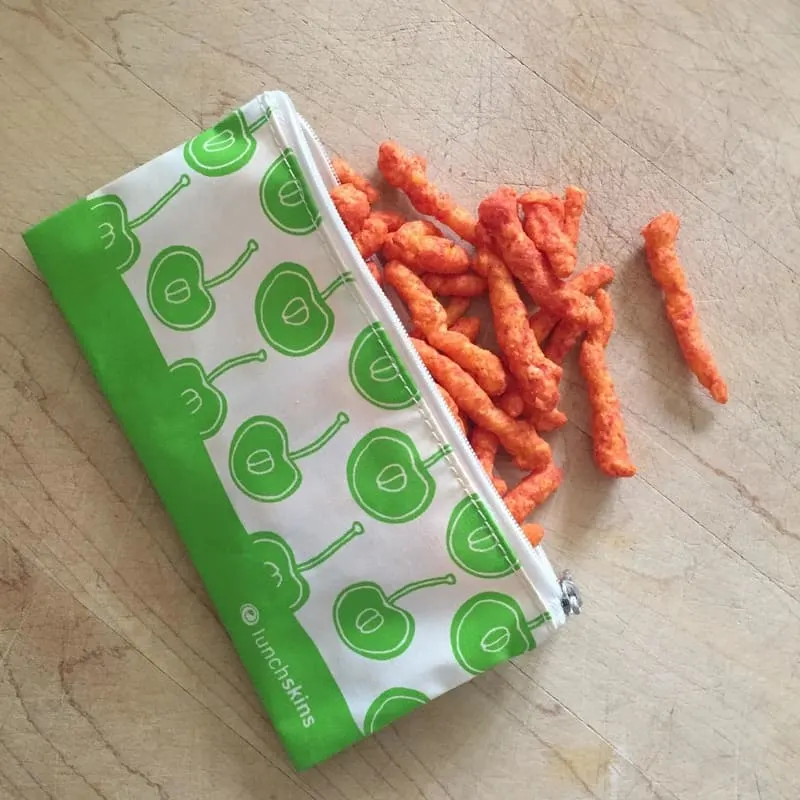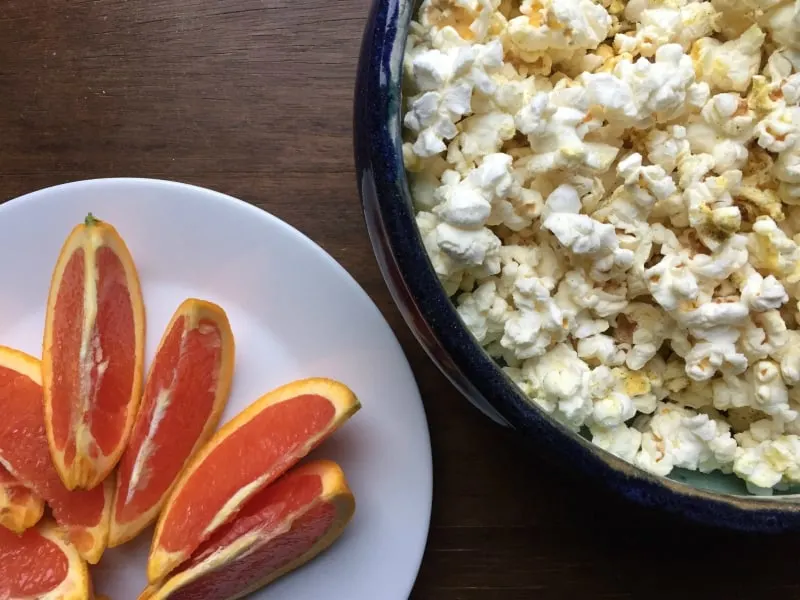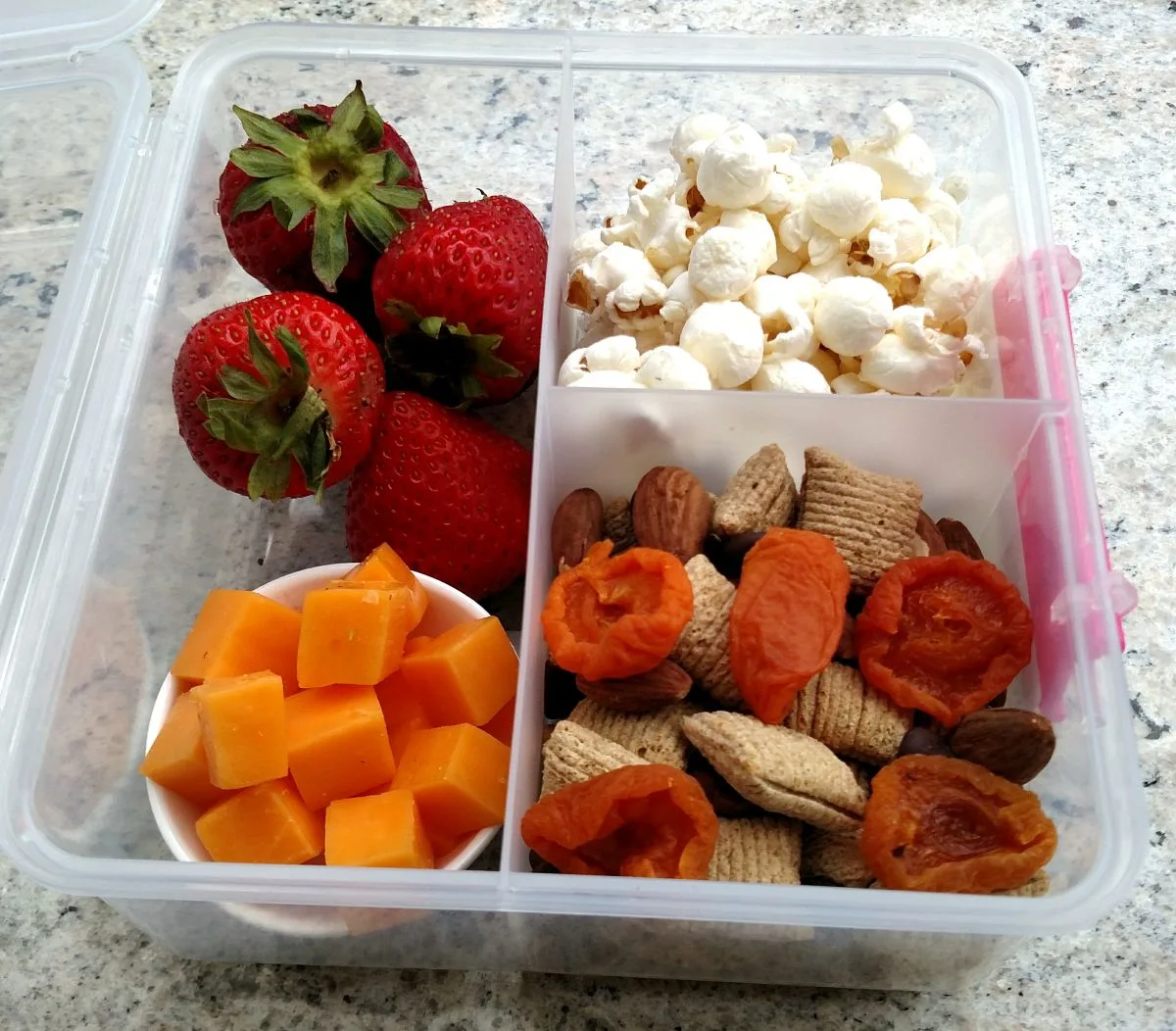Have you noticed that kids seem to be so much hungrier in summer? Maybe it’s boredom, maybe physical activity, maybe growth spurts, but no matter the reason, the struggle to avoid the never-ending, “what is there to eat???” question is real. To help you survive the snacking season, I came up with some ideas and tricks so you know how to feed kids who are always hungry.

How to Feed Kids Who Are Always Hungry
What is it about summer that makes kids so ravenous? Over the years I have concocted a number of (totally not based on science) theories ranging from additional physical activity to increased Vitamin D to boredom, but none of these pan out to be consistently connected to the insatiable hunger that causes the constant clamoring for snacks and meals. No matter the reason, the challenge as parents of these ever-ravenous beasts remains: how to feed kids who are always hungry.
And even more specifically, how to make snacks available in such a way that we don’t spend all of our time in the kitchen and they (mostly) eat healthy options.
The Struggle is Real
Just the other day, I took my younger son to his guitar lesson only to return an hour later to discover that my older son had eaten a bowl of leftover pasta, a quarter of a watermelon, a bowl of cheese puffs, two rice crackers with peanut butter, and was asking when dinner would be ready! Where does it all go?!
The frustration for me with feeding the bottomless pits that seem to be my children is that if I’m not organized and ready for the incessant call for snacks, they will resort to pre-packaged options which do little to keep them full or help their growing bodies.
But my desire to spend more time in the kitchen preparing non-stop snacks is low, so I have done two things: established some guidelines that I ask the boys to follow as best they can and come up with simple tricks that make providing healthier options snacks easier.

The Snack Battles in My House
This change in approach came after I realized that I had successfully managed to eradicate the dinnertime battles, but that the fights over snacks continued. Before changing my approach, here’s what things often looked like in our house:
Son: “Can I have a snack?”
Me: “Absolutely, you can get something from the kitchen.”
{time passes as son looks for a snack}
Me upon seeing his snack of choice: “Wow. That is a really big bowl of chips/crackers…” (Note: can you hear the judgment here? Mistake #1.)
Son: “It’s not that big!”
{two minutes later, after first bowl has been inhaled, son is back in the kitchen}
Me: “What are you getting now?” (Note: here I’m trying to control things. Mistake #2.)
Son: “More chips.”
Me: “That was enough! Can’t you get something else that has some more substance to it?” (Note: lots of judgment implied here as well. Mistake #3.)
Son: “But I want more chiiiiiippppssss.”
Me: “No. No more. That’s enough! Find something else!” {This often resulted in a meltdown, thereby proving that being rigid about food and/or fighting over food is never a good idea.}
OR
“Why don’t you try something else first. If that doesn’t work, then we can talk about the chips again.” {This often resulted in an eye roll, but usually also led to some fruits, vegetables, and/or whole grains getting eaten.} (Note: with both of these responses I was still being judgmental and controlling. Mistake #4.)
So after repeating this exhausting and tense pattern for many years I came up with a new approach, a simple set of guidelines for my kids to follow when it comes to snacks as well as some ways to make the healthier options more accessible.
By doing this, I was able to provide structure that made healthier options easier, but also flexibility so that they have the freedom to choose what is right for them.

Thoughts on “Junk” food
For years, I had a running battle both with myself and my kids about “junk” food. While I have always believed in enjoying chips, cookies, and other “junk” food in moderation, and therefore have always allowed those items into our house, they were always a source of contention.
This is because I would try to limit everyone’s (including my own) intake of these foods.
I would worry that everyone would just fill up on “junk” and then meals would be ruined. And I worried about sodium and sugar intake.
But after becoming well-versed in both the Division of Responsibility approach to feeding kids and the Intuitive Eating approach to feeding myself and my family, I realized that by limiting and controlling these foods, I was creating a sense of scarcity and, therefore, a premium on these foods. I was, in effect, making them more desirable, rather than just one of many types of foods we enjoy.
So when I began the work to change the dynamics around snacks and figure out how to feed kids who are always hungry without too much effort on my part, I decided to change the way “junk” foods were offered.
Specifically, I stopped restricting them. Chips, cookies, etc. were all now just part of what was available, just like fruits, vegetables, proteins, and whole grains.
I’m gonna be honest, for a few weeks I had to just hold my breath and watch as my kids went crazy. Full bags of chips would be gone in a day, while other, healthier, snack options were largely ignored.
But then something amazing happened. A bag of Doritos sat in my cupboard, unopened, for over two weeks. After the initial excitement wore off, this previously highly valued food item became routine and the kids started to seek out healthier options on their own. Rice cakes, tomatoes, and watermelon were suddenly appealing again.
And the truth is, these sorts of foods are popular because they taste good, but they are also popular because they are convenient. And when you’ve got kids who are always hungry, sometimes the convenience of these pre-packaged foods is just worth it.

Snack Guidelines
So after learning my lesson about the battles over snacks and “junk” food, I came up with five simple snack guidelines that I have set up for my kids:
- Only fruits or veggies in the hour and a half before dinner. This is for two reasons: 1) I want them to eat a good dinner and 2) if they fill up on produce, then at least I know they have nutritious food already in their bellies.
- How hungry are you? I ask my kids to assess their hunger level to determine whether they need a more robust snack or just a little something to tide themselves over until the next main meal. This helps them both to learn to listen to their bodies more and to plan their snack better.
- Is your previous meal finished? If not, finishing anything that can be finished from that meal comes first. This is especially relevant for packed school/camp lunches, which sometimes come home with the main item finished, but fruits and veggies left. (Note: I don’t force my kids to finish their lunches, but if there is some still-ok-looking fruit or vegetable that they picked out for themselves in the morning still in there, I do encourage them to eat it as I believe it is important to try not to waste that food.)
- Please consider fruits and vegetables as part of your snack. (Note: I don’t insist on any specific food group as I want them to build their own, healthy relationship with food, but I do want to remind them of the value of certain foods.)
- Still hungry? Assess what you need. If after a snack they are still hungry, I ask them to consider whether they need just a little more snack or whether their growing bodies need something more substantial.

How to Make Healthy Snacks Easy
The other piece of this puzzle that I have found to be important is to make the healthier options readily accessible, obvious, and appealing—the low-hanging fruit, if you will. I do this in a few ways:
- The fruit bowl. I try my best to make sure that there are fruits readily available on the counter. For most of the year that includes fruit in a fruit bowl such as oranges and kiwis in the winter and stone fruit in the summer. In the early summer, when berries are at their peak, I also try to have berries out on the counter ready to go. My boys also love grapes and Campari tomatoes, so I try to leave a container of those out as well.
- Veggies at eye level. I try to store cut up vegetables that are ready for the taking right at eye level in the fridge. Bell peppers, cucumbers, snap peas, and baby carrots are often kept in a container, so that when the boys aimlessly open the fridge, it is one of the first things they see.
- Offer to make a dip. I often have a yogurt dip or hummus pre-made and ready to go, but if I don’t, I will happily whip up a quick yogurt dip (the simplest, savory version is just plain yogurt, a drizzle of olive oil, a squeeze of lemon juice, some garlic powder, herbs, and salt and pepper) to make veggies more appealing.
- Whole grain crunchy snacks are always available. I make sure to always have popcorn and brown rice cakes available, and at eye level, in the pantry.
- Healthy baked goods are always in the freezer. I have written before about how I like to make a double (or these days triple) batch of baked goods over the weekends. Made with whole grains and often fruits or vegetables, these can make breakfasts easier, but they also serve as a great nutritious snack source. Recently, my boys have been super into rhubarb muffins and these scones.
- Leftovers are always an option. My kids aren’t usually fans of taking leftovers to school or camp for lunch, but they often enjoy them as part of snack. Since I am confident that these dishes are filling and nutritious, they know they are always welcome to them.
Want more snack ideas? Check out our list of simple snack ideas.
Between the guidelines and making the healthier options available, I have found that my kids are both more likely to seek out options that truly sustain them and that the tension and frustration around snacks has dissipated hugely.
Do you have tricks on how to feed kids who are already hungry? I’d love to hear them in the comments!
If you’d like to make feeding your family easier, try a free trial of our online meal planning service to see how simple planning, easy cooking, and joyful eating can be!

Mary Ellen
Saturday 3rd of June 2023
This is sooo helpful! Thank you for sharing it. I am interested in how old your are/were when you began this approach.
Jessica Braider
Sunday 4th of June 2023
I'm so glad that you found it helpful! My kids were about 5 and 7 when I started using this approach with snacks, but I'd say that you could definitely start this when they're toddlers!
Logan Campbell
Tuesday 11th of April 2023
Thank you for this! I’m going to try this approach this summer as I have created tension in kitchen with snacks and food in general. I love the division of responsibility but it is still hard for me sometimes to let go of control. With snacks- sounds like you didn’t have set times correct? Would love to hear more about your routine and my kids are getting older and I need to give them more freedom but still worry about creating bad habits. Thank you!!
Jessica Braider
Tuesday 11th of April 2023
Hi Logan, So glad you found the article to be helpful! I hear you on how hard it is to let go of the control - this is something that has taken me years to unlearn and I still find that I have to bite my tongue a lot. Now that my kids are older, other than the only fruits and veggies in the hour and a half before dinner piece, I have given up on a schedule for snacks. When they were younger, I did usually have more set meal and snack times, mostly so that they could learn to identify their hunger cues. When you let go of the control and loosen the rules, as I said in the article, there likely will be some crazy gorging on snacks, but as it all gets normalized I have found that the better habits start to take shape. Another mini-tip: you can definitely limit how much of the foods that you worry about come into the house and maximize the more nourishing choices. So, for instance, I usually get one bag of classic "junk" food a week and once that's gone, they can choose from other options such as popcorn, pretzels and hummus, etc. I hope this helps!
Healthy Summer Desserts & Getting Kids to Cook
Friday 12th of June 2020
[…] life we are living: a summer with no camp. Summer is already a time of year when the clamoring for snacks and treats can be a bit tricky, but this year when the boys will be home so much more than usual, I suspect the desire for fun and […]